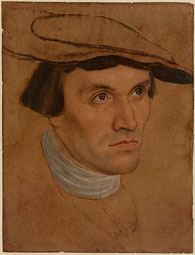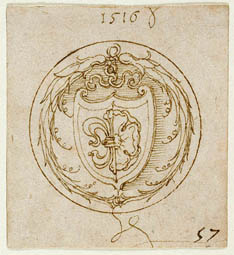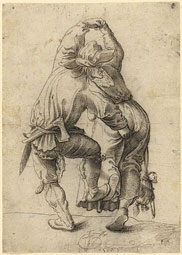|
The Renaissance in German-speaking lands roughly spanned the years 1470–1600, and time in which diverse art forms flourished in this region. On display in this exhibition are drawings from the Museum's collection made as studies for works in other media including sketches for paintings, prints, stained glass, and metalwork, as well as highly finished drawings made as works of art in their own right.
The drawings all originated in a geographic area corresponding approximately to present-day Germany and Switzerland. Important artistic centers included Strasbourg and Basel in the Upper Rhine region, where Martin Schongauer, Hans Holbein the Younger, and Urs Graf were active; Nuremberg, home of Albrecht Dürer and his school; and Wittenberg in northeastern Germany, where Lucas Cranach the Elder served as court painter to the dukes of Saxony.
In Portrait of a Young Man, the subject's clear, open eyes and the slight forward incline of his head project intensity of thought. The sketchy rendering of his beret and collar focuses attention on the meticulous depiction of his face, with its smooth, unbroken planes. It is known that Cranach was a friend and portraitist of Martin Luther, leader of the Protestant Reformation. Cranach also immortalized the Protestant Saxon court in a way parallel to (though stylistically very different from) Hans Holbein the Younger, artist to the Tudor court in England.
|
 |
|
Most German and Swiss draftsmen of the Renaissance, however famous, did not limit themselves to drawings for paintings or prints but also made designs for applied arts. Circular drawings were often designs for stained glass panels. Glass painters would translate the drawings onto glass, usually on a one-to-one scale. After a panel was assembled, the painter drew with vitreous glass paint, which was then fired and fused.
Artists also created decorative patterns to be engraved into gold, silver, and pewter plates and cups, or made profile drawings for portrait medals that were modeled in clay and then cast in bronze, providing permanent mementos of illustrious individuals. Even famous painters such as Albrecht Dürer created designs for pendants and rings, which were then given to goldsmiths to execute.
|
 |
|
Non-religious subjects, ranging from lovers to soldiers to peasants, became widely popular. As a holdover from the Middle Ages, scenes of courtly love and pageantry included young couples having dalliances outdoors, men in fool's caps tempting maidens, and playful jousts that offered lively imagery for stained glass, paintings, and prints.
Constant warfare depended on soldiering as an important source of employment for young men, and so the mercenary soldier (Landsknecht in German) also became a favored theme in art. A fixture of 16th-century life, peasants were tied to the land and viewed by city dwellers as rustic bumpkins, partly to be satirized and partly to be feared. Male peasants were often depicted with disheveled hair, threadbare clothes, and large weapons. Female peasants were frequently shown as thickset beasts of burden or overbearing crones.
|
 |
|
Located on an international trade route, Nuremberg became Germany's most important artistic center during the 16th century. Aside from its merchant-wealth, the city was also a locus for humanist learning, which stressed the revival of classical antiquity as promoted by the Italian Renaissance. Dürer brought additional renown to the city as northern Europe's most prominent artist in the early 1500s.
Before Dürer made his renowned drawings of plants and animals directly observed from life, Martin Schongauer pioneered this art form in meticulously rendered drawings and watercolors of plants—such as Peonies—decades earlier. Dürer was a great admirer of Schongauer's art, just as he too, was to inspire a generation of younger artists.
|
 |



